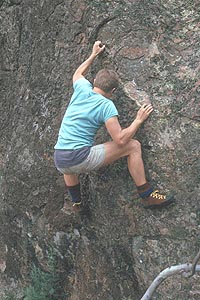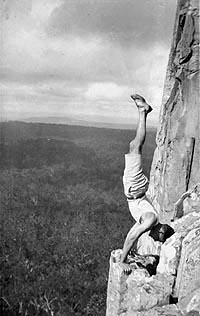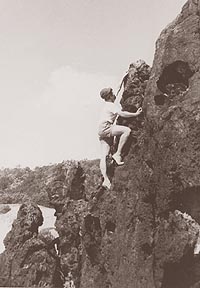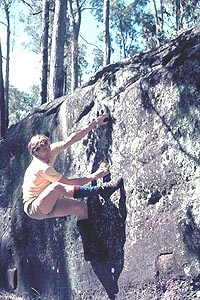Some
Recollections on the Origins of Bouldering in Australia
By Ted Cais
I was fortunate to have been a young protégé of Albert A.
Salmon, who pioneered the first golden age of Australian climbing
around Brisbane in the 1930's, and to have participated in the second
great era from 1960 to 1975, when technical difficulty approached world
standards, at least in the crack climbing developments led by Rick
White at Frog Buttress.

This background provides me with a unique insight into the origins of
bouldering there, even though it excludes similar interstate activity
in Sydney and Melbourne that evolved rather independently owing to
geographic isolation. These capital cities also had their local
climbing clubs and regional bouldering spots (Lindfield Rocks and
Hanging Rock, respectively) that were utilized from at least the
mid-1950's.
(Cais
on a John Moore boulder problem at Hanging
Rock, Victoria 1970 - Photo by K. Jensen)
Australia was first strongly influenced by Britain, being a far-flung
outpost of the Empire, but developed its own frontier spirit
appropriate to a new colony with vast spaces and a small population, in
contrast with England’s village culture. The area is blessed with good
weather and an abundance of crags close to urban centers. Early
climbing evolved as an extension of hiking (known as bush walking) and
focused on exploration and the capture of new summits by the line of
least resistance.
 Salmon was a
tireless walker who achieved many first ascents of major
rock peaks in southeast Queensland. He was eccentric with
strong convictions and a personal ethic that excluded the use of rope
and other forms of protection as unsporting. For safety, he
relied on three points of contact with the rock and leg power, so
hiking long distances over rugged terrain was necessary and sufficient
training, although he did have natural gymnastic talent. His
favored climbing shoe was the plimsole or tennis sneaker (called
sandshoes in Australia) unlike the rigid nailed boot used
contemporaneously in England. He rarely sought out intrinsic
difficulty for its own sake because he had to be certain he could
safely stay attached if a hold broke and downclimb unaided.
Salmon was a
tireless walker who achieved many first ascents of major
rock peaks in southeast Queensland. He was eccentric with
strong convictions and a personal ethic that excluded the use of rope
and other forms of protection as unsporting. For safety, he
relied on three points of contact with the rock and leg power, so
hiking long distances over rugged terrain was necessary and sufficient
training, although he did have natural gymnastic talent. His
favored climbing shoe was the plimsole or tennis sneaker (called
sandshoes in Australia) unlike the rigid nailed boot used
contemporaneously in England. He rarely sought out intrinsic
difficulty for its own sake because he had to be certain he could
safely stay attached if a hold broke and downclimb unaided.
(Salmon
doing a head stand on the East face of
Crookneck in the Glasshouse Mountains, north of Brisbane circa 1929)
Perhaps his most visionary achievement was the first solo ascent of
“Fly Wall" at Katoomba, in the Blue Mountains just west of Sydney in
1934. This certainly can be regarded as a "highball" boulder
problem. Salmon’s usual limit (based on the three-point contact
rule) approached 5.6, but on that day he excelled himself under the
challenge issued by Dr. Eric Dark, another significant historical
figure in Australian rock climbing. The difficulty may well have
been 5.7, corresponding to the first “Very Severe” or VS on the English
scale.
Of course this difficulty pales in comparison to earlier European
achievements like those of Oliver Perry Smith (Elbsandstein) and Paul
Preuss (Dolomites) but Australia was so parochial at the time they had
to build local standards from scratch without the benefit of outside
knowledge. Salmon collected an extensive library of books, but
most were on Himalayan and Alpine adventures and hardly relevant to
technical rock climbing.
It took another 30 years for Australian standards to break the 5.10
barrier. The leading exponents in the 1960’s were Bryden Allen and John
Ewbank, both British expatriates living in Sydney. Their
firsthand experiences of overseas climbing and natural abilities
accelerated the pace of development to these levels in our neighboring
State of New South Wales. Allen brought the first PA climbing
shoes to Australia and invented the “carrot” bolt with removable
hanger.
I was still in high school in 1962 when Salmon introduced me to many of
his climbs, but his strict ropeless ethic inhibited my
development. I joined the school rowing team (crew) and started
weight training that soon conveyed benefits for climbing in a more
aggressive style utilizing upper body strength. Before then the
application of dynamic movement was regarded as inappropriate under the
old culture of "the leader never falls".
As far as I know I was the first Australian climber to systematically
train with weights and still believe the power clean with bodyweight is
one of the best overall exercises. Unfortunately the development
of climbing flexibility and finesse became neglected in this obsession
for raw power.
Up to this point bouldering never was taken seriously as a sport in its
own right. We had the conventional view it was a game or trifling
diversion from real climbing involving multi-pitch roped ascents of
large cliffs. Moreover there are few acual boulders in Brisbane
that, by virtue of limited height, would focus our efforts
suitably. The favorite training ground was Kangaroo Point, a 20-m
quarry face that encouraged toproping, although I added several hard
boulder problems on a smaller section of the cliff (W1).

The sea cliffs at Noosa and Stradbroke Island were early popular
bouldering venues since the sandy beaches made for safe landings.
Salmon climbed
there extensively, even if this activity was
an adjunct to a social surfing party. Manmade structures like
buildings and bridges were popular too since they offered long
traverses at a comfortable height. Naturally these favored
endurance over absolute technical difficulty.
(Cais
bouldering at Point Lookout, Stradbroke Island,
1962 - photo by A.A.Salmon)
The closest classic boulders were in Stanthorpe, an outlying provincial
town where the surrounding fields are littered with coarse-grained
granite boulders. I first visited the area in 1962 with the
primary objective of scaling every boulder. Even the
simplest way up could be challenging thanks to the rounded and overhung
sides.
I would say bouldering for its own sake, that is the desire to execute
a specific sequence of intense movements, started in the early
1970's. This was enabled by our discovery in Toohey’s forest of a
small boulder field nestled in the trees of a local suburb that offered
a texture like gritstone with small nubbins to tweak on. For
the first time individual problems were marked, a circuit established
and difficulties attained V1.
 (Cais at
Toohey's forest in 1974 - Photo by K. Jensen)
(Cais at
Toohey's forest in 1974 - Photo by K. Jensen)
Around this time we outgrew our British heritage and learned of the
exciting developments in the USA that culminated in Rick White’s first
Australian ascent of The Nose and Salathe Wall in 1973. I was
inspired by an article on John Gill to try "chalk" in the same
year. Alas, I didn't realize it should have been magnesium
carbonate and used "rosin" instead. It was a short-lived
experiment that generated a sticky mess in the Australian heat!
Proper chalk was not adopted till after the visit of Henry Barber in
1975.
These early beginnings were replicated elsewhere in Australia at
similar times but none were significant breakthroughs in the wider
international context. These were left up to the Australian
tennis players, swimmers, distance runners and cricketers, to cite a
few sports. Still, these few pioneering climbers laid good
foundations for succeeding generations to participate with the best.
WEBSITE: W1 Kangaroo
Point 1968
http://members.tripod.com/tecais/

 Salmon was a
tireless walker who achieved many first ascents of major
rock peaks in southeast Queensland. He was eccentric with
strong convictions and a personal ethic that excluded the use of rope
and other forms of protection as unsporting. For safety, he
relied on three points of contact with the rock and leg power, so
hiking long distances over rugged terrain was necessary and sufficient
training, although he did have natural gymnastic talent. His
favored climbing shoe was the plimsole or tennis sneaker (called
sandshoes in Australia) unlike the rigid nailed boot used
contemporaneously in England. He rarely sought out intrinsic
difficulty for its own sake because he had to be certain he could
safely stay attached if a hold broke and downclimb unaided.
Salmon was a
tireless walker who achieved many first ascents of major
rock peaks in southeast Queensland. He was eccentric with
strong convictions and a personal ethic that excluded the use of rope
and other forms of protection as unsporting. For safety, he
relied on three points of contact with the rock and leg power, so
hiking long distances over rugged terrain was necessary and sufficient
training, although he did have natural gymnastic talent. His
favored climbing shoe was the plimsole or tennis sneaker (called
sandshoes in Australia) unlike the rigid nailed boot used
contemporaneously in England. He rarely sought out intrinsic
difficulty for its own sake because he had to be certain he could
safely stay attached if a hold broke and downclimb unaided. 
 (Cais at
Toohey's forest in 1974 - Photo by K. Jensen)
(Cais at
Toohey's forest in 1974 - Photo by K. Jensen)